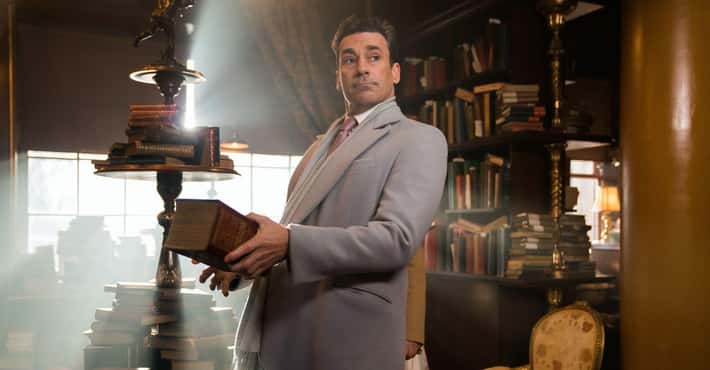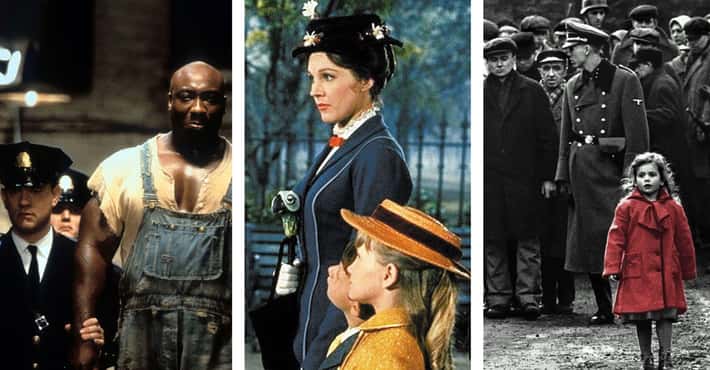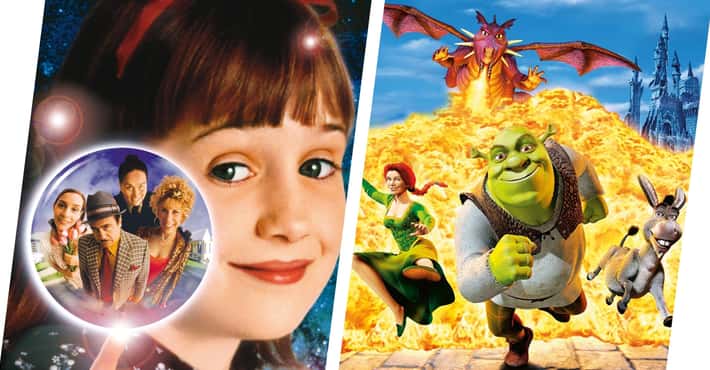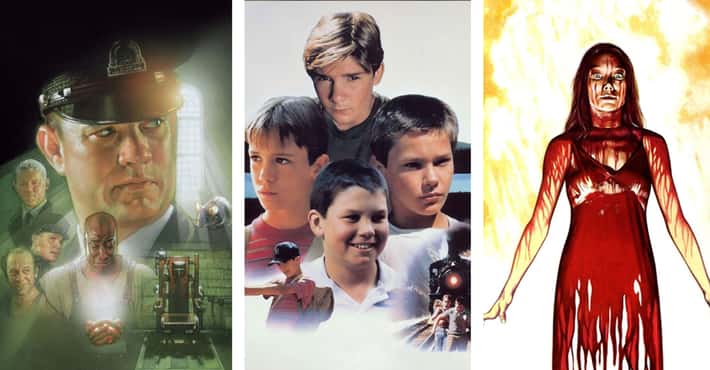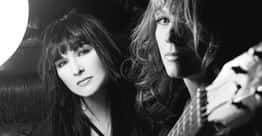17 Supposedly Unfilmable Books That Got Filmed Anyway
If you were to read through a list of the highest-grossing movies of all time or the best movies ever made, you’ll find that a sizable proportion of them are based on books. The Avengers, Gone with the Wind, The Godfather, and The Shawshank Redemption (to name a few) all have literary origins, but not all books are easily adapted to the screen, and some of them are downright “unfilmable.” Books and movies are very different art forms, and not all stories translate well. It’s difficult to imagine movies like Alfonso Cuarón’s Gravity or the classic musical Singin’ in the Rain as anything other than cinematic spectacles, just as it’s hard to visualize the work of Kurt Vonnegut or David Foster Wallace on screen. But Hollywood has a long track record of filming the unfilmable - and sometimes they even get it right.
Before Peter Jackson monopolized the box office and the Oscars with his Lord of the Rings trilogy, Stanley Kubrick thought Tolkien’s novels were unfilmable. Dune was also deemed impossible to adapt - previous attempts not withstanding - only to be turned into a box office and critical hit when Denis Villeneuve stepped in. But no matter what the reviews or balance sheets say, it’s always a matter of opinion whether a movie succeeds at capturing the essence of its source material. So whether you’re a movie buff or one of those people who almost always think the novel was better, vote up the books that got surprisingly worthy adaptations despite the odds.
- 11,184 VOTESPhoto: Paramount Pictures
German author Peter Süskind resisted selling the rights to his novel Perfume: The Story of a Murderer for nearly two decades, believing that its focus on scent could not be captured on film. Set in 18th-century France, it follows Jean-Baptiste Grenouille, an orphan from a Paris slum who possesses an unparalleled sense of smell. His abilities give him a knowledge of the world that is more animalistic than human, and his obsession with preserving the natural scent of beautiful women and make something of his life drives him to serial murder. The book is full of lengthy descriptions of smell that immerse the reader in Grenouille’s experience. They are as pivotal to the plot as they are to the atmosphere, and Süskind believed that only Stanley Kubrick or Miloš Foreman could translate his work to the screen. But Kubrick declined, allegedly declaring the book to be unfilmable. Süskind eventually sold the rights to a producer friend who brought in Run Lola Run director Tom Tykwer to adapt it. The result was bold and divisive.
Tykwer dismissed the idea that the novel was unfilmable, arguing that books can't mimic scent any better than movies can. He tackled the challenge in several ways. A voiceover from the velvet voice of John Hurt details Grenouille’s early life, but visual cues are also employed. The camera soars, speeds, and hovers over the objects Grenouille is smelling – oysters, feet dancing in a puddle, plums, and hair. When he catches the scent of a beautiful woman for the first time, only her neck and hair are shown, suggesting that he reads people through their smell rather than their expressions. Ben Whishaw’s performance as Grenouille brings out the uniqueness of the character in other ways. He is twitchy, detached, and monosyllabic, and his gruesome experiments on the corpses of his victims appear more clinical than predatory. The soundtrack offers yet another way into the olfactory nature of the story. When Grenouille encounters the smell of young women or concocts the perfect formula, the music is soaring and ethereal, as if he’s opened the gates to heaven. Reviews were mixed, but even negative ones acknowledged that the director achieved a saturated multi-sensory experience.
- 21,621 VOTESPhoto: Warner Bros.
For decades, comic book heroes were the unquestionable good guys, but Alan Moore and Dave Gibbons changed that. With their series Watchmen, they challenged the “good vs. evil” binary of the superhero genre by showing the risks and consequences of having a class of superhumans wielding unchecked power. Setting the story in an alternate reality in which America has won the Vietnam War, Watergate was never uncovered, and the US and Russia are hurtling toward a superhero-fueled nuclear apocalypse, Watchmen was the antithesis of the escapist fantasy provided by earlier comics. While it subverts the stereotypes, it also leans into the form, filling every page of its 12 issues with intricately rendered story building. Because of this, Moore was bitterly opposed to seeing his creation turned into a movie. “With a movie, you are being dragged through the scenario at a relentless 24 frames per second,” he said. “With a comic book, you can dart your eyes back to a previous panel, or you can flip back a couple of pages. Even the best director could not possibly get that amount of information into a few frames of a movie.” For this reason, Watchmen was labeled “unfilmable” by Terry Gilliam, one of the most tenacious and imaginative directors in the industry, and the rights were mired in development hell for more than two decades before Zack Snyder took over.
2009’s Watchmen remains divisive even when compared to the rest of Snyder’s DC filmography. Fans complained that it was too faithful to the series (the unnecessarily dense verbatim exposition) and not faithful enough (the missing giant squid and undermining of Moore’s philosophy on superheroes). Critics were also torn, alternately citing Snyder’s bombastic style as equivalent to being hit over the head for 163 minutes and proof that the genre is home to some of the best young minds in Hollywood. The review in The Los Angeles Times was simply titled “It was unfilmable.” In 2019, Damon Lindelof took a different approach to adapting Watchmen, proving that perhaps the only way to faithfully capture the spirit of Moore’s work is to create an original sequel that spans multiple episodes.
- 3715 VOTESPhoto: Columbia Pictures
True crime stories are catnip for Hollywood producers, but Susan Orlean’s 1998 book The Orchid Thief presented unique challenges for the filmmakers trying to adapt it. Chronicling the author’s investigation into the world of competitive orchid growing after a well-known collector was caught poaching a rare species from a state preserve, it’s a subjective, meandering story with none of the action and peril that's central to most true crime movies. Charlie Kaufman found the task of adapting the book so torturous that he wrote a script about his agonizing process rather than Orlean’s story, opening up a whole new avenue of possibilities for how filmmakers might approach the dreaded “unfilmable” book.
Adaptation follows a fictionalized version of Kaufman (played by Nicolas Cage) as he struggles to turn Orlean’s novel into a movie script. He’s grappling with the success of his first feature, Being John Malkovich, as well as anxiety and the appearance of his deadbeat brother Donald (also Cage) who has taken up an interest in hackneyed screenwriting. Charlie finds his way into the story after a series of dramatic events gives him blockbuster-worthy writing material. Meryl Streep plays Orlean, who is having a secret affair with the Florida orchid thief, John Laroche (Chris Cooper). The Kaufmans discover that the couple is deriving a drug from the stolen orchid, a revelation that leads to an action sequence, murder, and, ultimately, a happily-ever-after ending for Charlie. Orlean described being in “complete shock” when she read the script for the first time and trying to block it from being made. Over time, however, she changed her mind and came to love the finished product. “What I admire the most is that it's very true to the book's themes of life and obsession,” she said. “And there are also insights into things which are much more subtle in the book about longing, and about disappointment.” By taking extreme liberties with the source material, Kaufman drew broad parallels between Orlean, himself, and Laroche, transforming a book that was ostensibly about a bizarre subculture into an illustration of passion, frustration, and the creative process.
- 4549 VOTESPhoto: Sony Pictures Classics
Unlike many “unfilmable” books, Virginia Woolf’s 1928 novel Orlando is not stylistically experimental or linguistically complex. Instead, its very premise is what led people to conclude it could never be translated to the screen. It follows 400 years in the life of the ageless titular character, who is a man at the beginning of the story but inexplicably transforms into a woman halfway through. “Nobody believed I could do it,” Sally Potter, the director of the 1992 adaptation, recalled. “There were lots of people who said, ‘Oh you’ve got to have two actors [play Orlando]. You’ve got to have a male actor first and then a female.’” But the director was adamant that the character be played by one person, and when she met Tilda Swinton, she knew she’d found the key to her adaptation.
Swinton’s career has been defined by her ability to play multiple genders, ages, and even species. When she met Potter, she was appearing in a play as a woman disguised as a man, but the director says it was her role as an alien cyborg in 1987’s Friendship’s Death that convinced her she was right for the role. As Orlando, Swinton embodies both male and female versions of her character, aided by the androgynous wigs favored by 15th-century noblemen. Potter opted to stray from the source material in multiple ways, explaining that her task was to “find a way of remaining true to the spirit of the book and to Virginia Woolf's intentions, whilst being ruthless with changing the book in any way necessary to make it work cinematically.” In the novel, Orlando’s gender switch is unexplained. In the movie, he transforms into a woman after experiencing a crisis of masculinity when he is forced to kill in battle. Similarly, as a woman in 18th-century England, Orlando struggles with femininity when she is unable to inherit land or attend literary salons. These changes make the character’s struggles with gender a matter of external rather than internal forces and offer a more pointed perspective than what Woolf could write in 1928. Despite its outlandish premise and indie roots, the film became an international hit, received two Oscar nominations, and launched Swinton’s movie career.
- 5292 VOTESPhoto: Annapurna Pictures
James Baldwin is primarily known for his essays and the vibrancy and evocativeness of his writing. His 1974 novel, If Beale Street Could Talk, resonates with his distinctive voice and follows the love story between childhood friends Tish and Fonny. When Fonny is imprisoned for a trumped-up charge of sexual assault, Tish learns she’s pregnant and fights to free him before the baby arrives. Their relationship is supported by Tish’s close-knit family, which goes to extreme lengths to help release him from prison and reunite the young couple. Baldwin’s story is nonlinear, poetic, and narrated from Tish’s perspective. With its vivid, almost musical descriptions of the couple’s romance and the interiority of the narration, the book and Baldwin’s work in general were considered “unfilmable.” When Barry Jenkins released his adaptation of If Beale Street Could Talk in 2018, it was the first English-language feature film of the author’s work.
Jenkins relied heavily on voiceover to capture Baldwin’s voice and stayed true to the novel by crafting lingering takes that mimic the pace of the source material. He even shot every scene in the book, though not all of them made it into the final cut. Beyond these choices, however, he was adamant that he tell the story in a cinematic rather than a literary way, and capitalized on music and cinematography to evoke the dreamlike romance and intensity of Baldwin’s words. From the sumptuous color palette to the floating overhead camera angle in the film’s opening, these distinctly cinematic devices practically swoon with the characters. The film received rave reviews from critics and was nominated for three Oscars, including best adapted screenplay, and Regina King ultimately won best supporting actress for her role as Tish’s fiercely loving mother. Critics called it “gorgeous [and] enveloping,” and a “mesmerising and wholly immersive experience.” The fact that these descriptions could just as easily be applied to Baldwin’s novel is perhaps the best evidence that Jenkins's adaptation was successful.
- #323 of 375 onThe Best Movies Based On Books
- #65 of 80 onThe Best Period Romance Movies
- #53 of 55 onThe Saddest Romance Movies That Will Make You Cry
- 6609 VOTESPhoto: Twentieth Century Fox
William S. Burroughs was so far ahead of his time that even decades after his death, his work is still obscene, shocking, and fringe. As a member of the Beat Generation, he produced writing that mocked and degraded the conservatism of the 1960s but still managed to be deviant to even the most liberal and disruptive literary movement of the day. Addicted to a vast array of drugs and openly queer at a time when homosexuality was prohibited in the US, he reveled in his transgressive persona by filling his writing with explicit content. His 1959 novel Naked Lunch features everything he believed in - sex, drugs, violence, and warped hallucinations. Following a junkie on the run through South America and Tangier, it unfolds in snippets that Burroughs asserted had “no real plot, no beginning, no end,” and could be read in any order. This intentional aimlessness makes a tricky novel even more difficult to adapt, but David Cronenberg did so to surprising acclaim.
The director had helped invent the body horror genre, but even he refused to put some of Burroughs’s book on screen, saying it “would be banned in every country in the world” if he followed it too closely. Instead, he drew on the author’s life as a writer to create a linear movie that could secure an R rating. The story revolves around exterminator Bill Lee (Peter Weller) who is beholden to his addiction to bug poison. His insecticide-fueled delirium presents him with a beetle with a talking orifice who convinces him that his wife is a secret agent of a nefarious organization, and he dutifully kills her. There are normal-sized cockroaches and human-sized mugwumps, all of whom hold Bill in a perpetual nightmare of gooey substances and paranoia. The movie didn’t land well with everyone, but some critics deemed it a masterpiece. Writing in the New York Times, Janet Maslin highlighted why Cronenberg’s decision to deviate from Burroughs’s novel was crucial to the film’s success. By turning the author’s explicit violence and depravity into something more metaphorical, he conjured a cinematic adaptation as daring and disturbing as Burroughs’s work, without attempting imagery so off-putting as to be self-defeating.
More Naked Lunch- #289 of 379 onThe Best Movies Of The 1990s
- #75 of 86 onThe Best Movies Of 1991, Ranked
- #28 of 69 onThe Most Confusing Movies Ever Made
- 7645 VOTESPhoto: MGM
When Vladimir Nabokov’s novel Lolita was published in 1955, it shocked readers and critics alike. The story of a middle-aged professor who becomes infatuated with a child and takes her on a cross-country odyssey of sexual assault in dingy motel rooms has hardly lost its shock value in the ensuing years and was turned down by every major publisher in the US. One of the rejection letters called the book “overwhelmingly nauseating, even to an enlightened Freudian” and recommended it be “buried under a stone for a thousand years.” It eventually received a limited release in France and made its way to America, where writers including Graham Greene and Dorothy Parker praised its layered, satirical portrayal of the protagonist and American culture. Before Lolita, Nabokov was a celebrated writer and translator teaching Russian Studies at Cornell University. Although the novel focuses on taboo subject matter, it is just as high-minded and complex as his previous work and can neither be dismissed as smutty and exploitative nor regarded as straightforward fodder for academics. For these reasons, Lolita was considered an unfilmable minefield - until Stanley Kubrick stepped in.
The director called the book “a masterpiece” but was forced to make changes to pass the Motion Picture Production Code. He removed the sexual relationship between the protagonist Humbert Humbert and Lolita and omitted any reference to her age, instead filling the script with double entendres to signal what’s happening between scenes. As a result, the movie heightens the comedic element of Nabokov’s novel, taking the edge off the sinister subject matter. Kubrick also chose to open the film with Humbert murdering his rival, a fellow middle-aged man obsessed with Lolita, hinting that he is a deranged and unreliable narrator. Starring James Mason as Humbert and 14-year-old Sue Lyon as Lolita, the film was released in 1962 to positive reviews. Critics praised its blackly comedic tone, though many took issue with Kubrick’s changes to the source material. Thirty-five years later, Adrian Lyne, best known for erotic '80s thrillers such as Fatal Attraction and 9 ½ Weeks, made an adaptation starring Jeremy Irons as Humbert. Though it adheres more faithfully to the book’s sexuality (Lyne used a 19-year-old body double in some scenes because the actress playing Lolita was below the age of consent), it removes Nabokov’s humor and fell foul of censors and fans of the novel.
More Lolita- Dig Deeper...The Real Story That Inspired "Lolita" Is Somehow More Disturbing Than The Actual Book
- #16 of 49 onThe Top 45+ Films Released In 1962
- #253 of 375 onThe Best Movies Based On Books
- 81,052 VOTESPhoto: Warner Bros.
David Mitchell’s 2004 novel Cloud Atlas is a collage of genres, characters, periods, and writing styles. Across more than 500 pages, it follows six storylines as far-flung as a 19th-century Pacific slave ship and a futuristic Hawaii after the apocalypse. Using a Russian doll structure, it places each story within the previous one through letters, books, and manuscripts read by the main characters. Each narrative is split in half on either side of an isolated story halfway through, beginning in chronological order and ending in reverse chronological order. It’s a difficult novel to describe, let alone adapt into a movie, and Mitchell knew it. “My only film-related thought when I was writing the book," he said, "was what a shame that no one would ever, ever film this. I was quite convinced it would never happen.” In less than a decade, however, the duo behind The Matrix series teamed up with German director Tom Tykwer to prove him wrong.
The Wachowskis and Tykwer devised an ambitious plan to shoot the movie on two full-scale locations simultaneously. Although every major film studio turned them down, they amassed a staggering $100 million from independent financiers and managed to cast Tom Hanks, Halle Berry, Jim Sturgess, and a host of other stars for the lead roles. The movie foregoes Mitchell’s nesting doll structure, opting instead to introduce all the characters in a montage up front and interweave the stories in a way that more closely matches the alternating structure used in many movies rather than attempting the episodic approach of the novel. They also used the same actors to play multiple characters, optimizing the visual element of filmmaking to highlight Mitchell’s theme of interconnectivity in a way the book couldn’t. The result is an overwhelming three hours that divided audiences. It was panned by some critics who scoffed at the wigs, prosthetics, and unabashed scope, and championed by others who were dazzled by its sweeping imagery and philosophical explorations of humanity and spirituality. For Tom Hanks, the whole thing was worth it just to see Hugh Grant play a cannibal.
More Cloud Atlas- #477 of 675 onThe Best Movies Roger Ebert Gave Four Stars
- #172 of 200 onThe 195+ Greatest Adventure Movies
- #22 of 69 onThe Most Confusing Movies Ever Made
- 9427 VOTESPhoto: Magna
Polish author Stanisław Lem wrote science fiction from an intellectual’s perspective. Dense, technical, and existential, his novels are revelatory to some and inscrutable to others. 1961’s Solaris is emblematic of this style. Set on a space station orbiting the eponymous planet, it follows psychologist Kris Kelvin, who is sent to investigate unsettling reports from the crew. The planet is covered in a gelatinous ocean the scientists believe is a sentient form of alien life, but after decades of work, their investigations have stalled. They believe the Ocean is retaliating against their destructive experiments by conjuring hallucinations and visitations from creatures in their subconscious. When Kelvin arrives, he's met by incarnations of his late partner, Harey, who appears to be as much a victim of the Ocean as its footsoldier. The novel delves into complex ruminations on the limits of knowledge, the hypocrisy of space exploration, and the technical aspects of the scientists’ attempts to communicate with Solaris. This makes it defiant to interpretation let alone adaptation, but Andrei Tarkovsky, a Russian filmmaker regarded as one of cinema’s greatest auteurs, tried his hand at it in 1972.
When the director met Lem to discuss the project, the author was overtly hostile and later described their encounters coolly: “I sat in Moscow for six weeks while we argued about how to make the movie. Then I called him a 'durak' [‘idiot’ in Russian] and went home…” Their differences stemmed from Tarkovsky’s desire to use the planet as a way to explore the characters' psyches rather than as a way to examine knowledge or human folly. His desire to make the film had nothing to do with science fiction but with ethical dilemmas raised by scientific discoveries. The result is unmistakably Tarkovsky’s work rather than Lem’s. It's languid, almost excruciatingly slow, and unlike the novel, alights on Kelvin’s life on Earth. Even when he gets to space 45 minutes into the film, science is of little concern. Instead, he falls in love with the clone of Harey, comes to terms with his role in her death, and encounters memories of his mother.
Steven Soderbergh made his own version of Lem’s novel in 2002 with George Clooney in the Kris Kelvin role (Called “Chris Kelvin" in this adaptation.). It’s less than half the length of Tarkovsky’s nearly three-hour adaptation and fared poorly at the box office, likely due to its disinterest in action, science, or futuristic technology. However, critic Roger Ebert compared it favorably to the earlier film, saying it was “like the same story freed from the weight of Tarkovsky's solemnity.”
More Solaris- #163 of 178 onThe 150+ Best Movies With Aliens
- #174 of 199 onThe Best Movies Of The '70s, Ranked
- #61 of 425 onThe Greatest Movies in World Cinema History
- Photo: Newmarket Films
Laurence Sterne’s novel The Life and Opinions of Tristram Shandy, Gentleman was wildly popular when it was released in 1759 and ahead of its time. Loosely strung together as an attempt by the narrator to write an autobiography, it features constant digressions, questions from an imaginary reader, and made-up words. Meanwhile, the main character hardly appears. The story begins in the passionate throes of his conception and doesn’t get to his birth until Volume III (of nine). The appearance of the story is equally unconventional. When the deaths of certain characters are mentioned, black pages commemorate their passing. In one section, Sterne inserts a blank page where the narrator invites the reader to imagine the most beautiful woman they can think of, “as unlike your wife as your conscience will let you.” Aside from these stylistic eccentricities, the constant digressions and absence of the main character make Tristram Shandy a nearly insurmountable struggle to adapt to the screen. English director Michael Winterbottom found an inventive solution, however, turning the story into a film-within-a-film.
Tristram Shandy: A Cock and Bull story stars British comedian Steve Coogan as “Steve,” an actor starring in a movie adaptation of Sterne’s novel. Throughout the film, he appears both as Steve and Tristram. The actor is self-absorbed, insecure, and constantly pulled in different directions. Worried about being upstaged by his co-star Rob (Rob Brydon) and preoccupied with the arrival of his girlfriend and baby, he is irritable and demanding, harping on the shoes his character wears and flirting with a production assistant. In one scene, he’s put into a harness and lowered head-first into a towering recreation of a womb. The filmmakers rethink the entire project. They shoot battle scenes only to remove them, argue over the day’s footage, and place a phone call to Gillian Anderson when they decide they need to add romance to the story. Like Sterne’s novel, the movie within the film is an unfinished, confounding project that tortures its narrator even as he makes irreverent jokes about it. Although the format is unusual and hyper-meta, it proves to be the perfect arena for its source material to thrive on screen.
- #617 of 675 onThe Best Movies Roger Ebert Gave Four Stars
- #69 of 102 onThe Best British Comedy Movies
- #33 of 86 onThe 85+ Best Movies With Story in the Title
- 11334 VOTES
Don DeLillo’s 1985 novel White Noise won the National Book Award and continues to be a cornerstone of Postmodern literature. Set in a fictional college town in the Midwest, it follows Jack Gladney, a professor of “Hitler Studies” who is forced to confront his fear of death when a railway collision spews noxious gasses into the air. His wife, Babette, is hiding a secret addiction to a new drug that staves off existential panic, and their clan of brilliant children (all but one from previous marriages) argues over the minutiae of global catastrophes while glued to the radio and television. Written largely in the form of dense dialogue and errant lists of objects and brands (“MasterCard, Visa, American Express”), White Noise is chock-full of academic satire and social commentary and was considered unfilmable for decades. Since it was published, however, its commentary on media saturation and consumerism has only become more relevant, and in 2022, Noah Baumbach took a stab at adapting it to the screen.
The director created a movie that is faithful to the source material but not always successful. He tried to recreate the novel's wide-ranging shifts in tone with a high-speed car chase, apocalyptic panic, elements of domestic melodrama, and madcap comedy. He also drew much of the dialogue directly from DeLillo’s writing, which occasionally sounds stilted and grandiose in the context of the movie. Reviews were mixed, with several noting that Baumbach was less successful with the tonal changes than DeLillo. Many praised the ambition of bringing the unfilmable to the screen, but frequent mention was made of the lighthearted tone of the film (it ends with an eight-minute dance sequence) in comparison to the dark undertones of the novel.
More White Noise- #103 of 153 onThe Greatest American Novels
- #7 of 64 onThe Best Postmodern Novels
- #2 of 34 onThe Best Novels About College
- 12284 VOTES
Winter's Tale
Photo: Warner Bros.Mark Helprin’s 1983 novel Winter’s Tale is a nearly 700-page magical realism love story set in New York. Irish gangs, a dying heiress, and a flying horse feature heavily, as do themes of capitalism, justice, and time travel. One of the protagonists is Peter Lake, a mechanic who meets the beautiful young socialite Beverly Penn while attempting to rob her parents’ mansion. Her death from consumption sends him on a quest for justice, and her spirit protects him until he gallops through a giant “cloud wall” and is transported into another era. Despite its explosion of fantastical storylines, the novel was a hit with readers and won glowing reviews from critics. The New York Times called it “utterly extraordinary” and named it among their 2006 list of best works of American fiction from the previous 25 years. This did not, however, guarantee a smooth transition to the screen. While fantasy offers rich subject matter for filmmakers, magical realism poses pitfalls that make it one of the toughest genres to adapt. Akiva Goldsman’s 2014 effort was derided by critics and flopped at the box office, highlighting how difficult it is to translate certain books to the screen.
Goldsman’s first concession was to eliminate 300 pages of the novel following the character Hardesty Marratta to focus on the love story between Peter and Beverly, but acknowledged that “the coexistence of magic and realism” was still an issue. “For me, I think those two things go hand-in-hand,” he said. “Some people don't.” Critics were in the latter category. Despite a stellar cast including Colin Farrell, Jennifer Connelly, and Will Smith, the movie was panned, with reviews calling out the laughably maudlin romance and “kitsch and preposterous” attempt at magical realism. The Irish Times noted the impossibility of adapting the genre, writing that “what seems fantastic on the page all too often seems fantastically idiotic on screen.” It’s no wonder that some of the most successful uses of magical realism in movies have employed the magical elements sparingly, such as the ambiguous ending of Birdman, the nightmarish twists of Black Swan, or the creature in The Shape of Water. Winter’s Tale was doomed the moment it tried to cram every fantastical element of Helprin’s book onto the screen.
- 13155 VOTESPhoto: Universal Pictures
Malcolm Lowry’s 1947 novel Under the Volcano is one of the defining books of the 20th century and is often cited as one of the greatest novels of all time. It follows the last day in the life of a former British consul living in Cuernavaca, Mexico in the lead-up to World War II. Over 12 chapters marking the 12 hours in the day, Geoffrey Firmin drinks himself into oblivion while half-heartedly attempting to reconcile with his estranged wife. Each chapter is told in a stream-of-consciousness style from the perspectives of various characters, and it's full of allusions to classical literature, including Christopher Marlowe’s Doctor Faustus and Dante’s Inferno. It’s a lengthy, tightly constructed tale full of poetic prose and symbolism. Translating this style into cinema is impossible, but if any director could faithfully capture the disintegration of a washed-up alcoholic with the requisite subjectivity and lack of sentimentality, it was John Huston.
For decades, directors including Orson Welles and surrealist filmmaker Luis Buñuel tried and failed to put Lowry’s work on screen. Huston’s track record of bringing the atmosphere of his locations into movies such as The African Queen and The Night of the Iguana made him a natural fit for a story whose setting is a character unto itself, and his eventual adaptation received rave reviews. Starring Albert Finney as Firmin, it focuses on the tragedy of its protagonist rather than the symbolism of Lowry’s book. The director’s decision to show the consul’s deterioration through Finney’s performance rather than through skewed camera angles and blurry focus makes the movie more of a character study than an exercise in surrealism, and critics were enthusiastic. Writing in The New York Times, Janet Maslin declared Lowry’s book unfilmable, but called Huston’s effort “especially impressive for the courage, intelligence, and restraint with which it tackles an impossible task.” Instead of capturing the novel through ponderous verbatim voiceover, Huston made it his own by focusing on the humanity of the consul and the incongruous vibrancy of the world around him.
More Under the Volcano- #492 of 675 onThe Best Movies Roger Ebert Gave Four Stars
- #84 of 92 onThe Best Movies Of 1984, Ranked
- #24 of 67 onThe Best Movies & TV Shows About Alcohol Addiction
- 14389 VOTESPhoto: Warner Bros.
Author Tom Wolfe was an iconoclast of the 1970s and '80s. With his unique blend of journalism and colorful prose, he captured his subjects with X-ray precision and became a poster child of “New Journalism” alongside Hunter S. Thompson and Truman Capote. Bonfire of the Vanities was an instant best-seller when it was published in 1987. Capturing the rampant greed and vanity of New York in the ‘80s with an indiscriminate gaze, it is both comical and withering. The plot revolves around a city-wide scandal over a hit-and-run incident in the Bronx that leaves a Black pedestrian severely injured. Wolfe uses his characters to dive head-first into cringeworthy stereotypes. From the WASPY Wall Street trader Sherman McCoy who, along with his virulently racist Southern mistress, is responsible for the accident, to a savvy Black pastor exploiting power for personal gain, no one is left unscathed. Other prominent characters include a self-absorbed Jewish prosecutor trying to impress an attractive member of the jury and an alcoholic English tabloid journalist. These heavily stereotyped portrayals were criticized by some critics but championed by others as an unflinching send-up of the ’80s. The novel’s popularity made a movie adaptation inevitable, but Wolfe’s work did not translate well in Hollywood.
Warner Bros. hired Scarface director Brian de Palma to direct the movie, hoping for another splashy spectacle, but they got cold feet over the incendiary elements of the story and tried to tone it down. In doing so, they gutted Wolfe’s novel. Fearing that Sherman McCoy wasn’t likable enough, they cast the only actor in Hollywood who could make him sympathetic: Tom Hanks. In the role of a tyrannical Jewish judge, they cast Morgan Freeman, allegedly hoping to stave off criticism for the portrayal of Black people in the story. In the role of the shamelessly self-serving British journalist, they cast Bruce Willis, who was in the midst of his action career and had no intention of modifying his acting style. None of these characters reflected Wolfe's, turning his biting satire into a madcap comedy that managed to be even “more uncomfortably racist” than the novel. Off of a $47 million budget, it only made $16 million at the box office.
- #315 of 329 onBooks That Changed Your Life
- #66 of 168 onBooks You'll Never Finish Reading
- #8 of 20 on20 Books That Deserve Much Better Adaptations Than They Got
- 15188 VOTESPhoto: Continental Distributing
Ulysses is one of the most notorious and celebrated books in the English language. Over more than 700 pages, James Joyce details the events of a single day in Dublin from the perspectives of three characters, loosely based on Homer’s Odyssey. The author boasted that he’d “put in so many enigmas and puzzles that it will keep the professors busy for centuries.” This has proven accurate. Swinging wildly between literary styles, unpunctuated streams of consciousness, and lurid accounts of sex and bodily functions, it’s an exploration of the possibilities of literature that shocked readers and was banned in the United States. The story follows Leopold Bloom, a pleasant but frustrated advertising agent who wanders the Dublin streets with Stephen Dedalus, a fatalistic, hyper-intellectual arts student. The final part of the novel is an unpunctuated inner monologue of Bloom’s wife, Molly, a singer who is having an affair. Despite the impossibility of translating Joyce's work to the screen, Ulysses was adapted in 1967 by American director Joseph Strick and was met with almost as much outcry as its source material.
Strick used voiceover for the inner monologues, literalizing Joyce’s work but losing much of its structural artistry and character complexity. The Guardian called his reliance on narration “an admission of defeat,” but acknowledged the futility of adapting the source material. Milo O'Shea plays Leopold with the kindness and sexual frustration of the character in the novel, while Maurice Roëves portrays Stephen with less self-awareness and academic pretension than Joyce’s characterization. Barbara Jefford took on the role of Molly, whose final monologue takes up more than 25 minutes of the movie and caused controversy for its lengthy, explicit meditations on sex. The Archbishop of Dublin called the movie “psychotic in its blasphemy and dirtiness,” and Strick withdrew it from the Cannes Film Festival after the French subtitles were removed. In New Zealand, audiences were separated by gender, and in Ireland, it was officially banned until 2000. Despite the moral backlash, critics praised its daring adherence to Joyce’s controversial work, and Strick received an Oscar nomination for best adapted screenplay. Given the confounding source material, this acknowledgment from the Academy was practically mandatory.
More Ulysses- #198 of 271 onThe Top Must-Read Books of All Time
- #131 of 437 onThe Best Novels Ever Written
- #68 of 82 onFamous Novels With The Catchiest First Lines
- 16130 VOTESPhoto: IFC Films
David Foster Wallace was a giant of postmodernism whose writing was occasionally dense to the point of opacity and involved copious footnotes, clauses, and obscure vocabulary. Although his work is generally regarded as uniquely unfilmable, John Krasinski chose one of his short story collections as source material for his directorial debut in 2009. Brief Interviews with Hideous Men is, like all of Wallace’s work, hard to classify. Four of the stories are titled “Brief Interviews with Hideous Men” and are formatted like interviews in which the questions are omitted and replaced with the letter “Q.” The narratives comprise unflattering portraits of masculinity, from a young wife’s preoccupation with her husband’s sexual timidity to a man who falls in love with a woman as soon as he discovers she was once raped and nearly murdered. Short story collections generally do not lend themselves to film adaptations because of their episodic and often barely connected narratives, but with Wallace’s distinctive writing style, Brief Interviews with Hideous Men poses a formidable challenge.
John Krasinski’s film was the first adaptation of the author’s work for the screen. For a first-time director, it was an ambitious project that fell flat with critics and audiences despite its frequent use of verbatim passages from Wallace’s work. Krasinski simplified things by replacing the author’s anonymous interviewer with a graduate student named Sara Quinn (Julianne Nicholson) who processes her recent breakup by interviewing various men about their romantic lives. Despite this throughline, the interviews are episodic and uneven, featuring a wide range of actors such as Chris Messina, Will Arnett, and Bobby Cannavale. Critics faulted the movie for being “painfully literal” without managing to capture the sharp edge of Wallace’s stories. “He read, he loved, and unfortunately, he did not conquer,” wrote Mary Pols in Time. If nothing else, Krasinski’s Brief Interviews with Hideous Men reinforced the notion that Wallace’s work cannot be adapted for the screen without losing the stylistic flourishes that make it unique.
- 17200 VOTESPhoto: Buena Vista Pictures
Kurt Vonnegut became a voice of counterculture in the 1960s and '70s with his satirical novels Slaughterhouse-Five and Cat’s Cradle. His writing combined poignant political commentary with absurdism and curmudgeonly humor, a balance that has proved difficult for filmmakers to reproduce. Breakfast of Champions was his seventh novel, and though it was a best-seller that was fawned over by critics, it was also one of his hardest works to adapt to the big screen. The book revolves around two characters, a local celebrity car salesman named Dwayne Hoover who is going insane, and an unsuccessful science fiction writer named Kilgore Trout. After reading one of Trout’s stories, Hoover is convinced that he is the only person in the world with free will and that everyone else is a robot. The book is full of Vonnegut’s facetious doodles and characters from previous stories. The author even makes an appearance at the end to set Trout and the rest of the characters free from serving him. With all these elements, it is not a book that cries out for cinematic adaptation, and Alan Rudolph’s 1999 effort failed miserably.
The movie stars Bruce Willis as Hoover, Albert Finney as Trout, and Nick Nolte as one of Hoover’s employees who is trying to hide his penchant for wearing women’s underwear. Despite the illustrious cast, the film is even more incoherent than Vonnegut’s plot, and a lot less fun. Willis’s performance is dialed up to a fever pitch from beginning to end, which, combined with the speed and eye-popping surrealism of the rest of the movie, is enough to exhaust a viewer within five minutes, let alone an hour and 50. There is a talking dollar bill, gelatinous concrete, and excessive slapstick humor, all of which add up to a mess so irredeemable that the movie was only released in 11 theaters. In attempting to be darkly cartoonish, the film version of Breakfast of Champions was “unwatchable” and unrecognizable as a Vonnegut adaptation.
- #12 of 19 on19 Forgotten Comedies Of ’80s Movie Stars
- #11 of 15 onThe Best R-Rated Tragicomedies
- #25 of 35 onThe 30+ Best Glenne Headly Movies



























